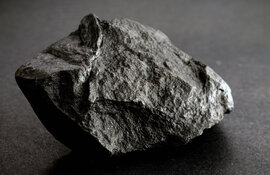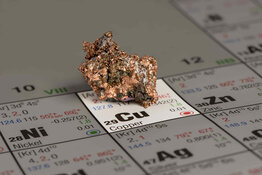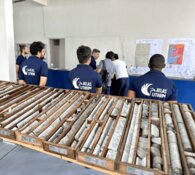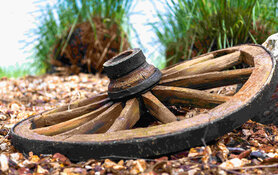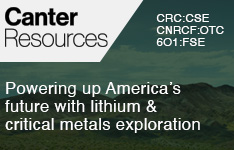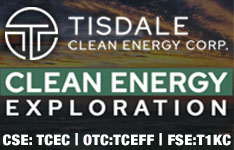Canter Resources Corp. (CRC:CSE; CNRCF:OTC; 601:FRA) announced initial brine and clay/sediment assay results from its completed 15-hole first phase shallow Geoprobe drill program at its Columbus Lithium-Boron project near Tonopah, Nevada.
Initial samples returned peak values of 3,070 parts per million boron (ppm B), 690 ppm lithium (Li), and 3.89% potassium (K) within highly mineralized sedimentary (clay) intervals starting from the surface and highly enriched brines containing more than 500 mg/L boron and more than 5,000 mg/L potassium (>5%).
"We are excited to see these boron-enriched brine concentrations and significant sedimentary intervals within the first ~30 meters along an extended strike length at Columbus," Canter Chief Executive Officer Joness Lang said. "Seeing boron-enriched brines and lithium-enriched clays in this shallow interval provides further proof-of-concept, supports our ongoing targeting, and speaks to the multi-commodity potential at Columbus."
Jeff Clark, author of The Gold Advisor, summed up his evaluation of what the drilling found in two words: "They hit."
"These first set of results showed there are strongly mineralized lithium-boron clays and boron-rich brines from shallow aquifers over 2 kilometers in strike," Clark wrote on Monday. "Elevated boron at or near surface is a good pathfinder for lithium at greater depth (where Canter's primary lithium-brine targets are), but management believes the shallow boron results are significant on a standalone basis."
Large amounts of lithium and boron are needed for the transition to clean energy, with both needed to create large amounts of electric vehicles (EVs).
Lang said boron production is currently "limited to a few regions and operators globally and with boron applications rapidly advancing across our most critical growth sectors, including semiconductors and EVs."
"We view the potential to define significant boron mineralization, domestically, as a tremendous opportunity," said Lang, who also gave a video interview with Strategic Advisor Michael Gentile on Blaze Capital Monday. "We are just getting started with our phased drilling approach and look forward to more results from Phase I before probing deeper in subsequent campaigns set to commence in early Q3/2024."
Based in Vancouver, British Columbia, Canter Resources is a junior lithium, boron, and critical metals explorer with two properties, now focused on advancing Columbus, its flagship asset.
"This project looks like it has world-class potential," wrote Chen Lin of What is Chen Buying? What is Chen Selling? on May 2. "They are not only exploring for lithium but boron as well."
The Catalyst: Boron-Enriched Brines, Lithium-Enriched Clays
The 15 shallow drill holes were completed to test the interpreted upper brine generation layer of the basin, the company said. The initial five drill holes (400 meters spaced in a north-south grid) consistently intersected aquifers, capturing saturated brines at shallow depths over 2 kilometers, returning significant near-surface boron-enriched brines and lithium-enriched clays.
Highlighted Brine Results include (total values):
- Hole CB24-012G: 454 milligrams per liter (mg/L) B, 43.5 mg/L Li, and 5,870 mg/L K at 17.37 meters depth
- Hole CB24-011G: 446 mg/L B, 41.2 mg/L Li, and 5,030 mg/L K at 12.19 meters depth
- Hole CB24-012Gx: 468 mg/L B, 15.3 mg/L Li, and 4,410 mg/L K at 19.05 meters depth
- Hole CB24-011Gx: 508 mg/L B, 2.8 mg/L Li, and 4,110 mg/L K at 0.82 meters depth
- Hole CB24-013G: 337 mg/L B, 49.8 mg/L Li, and 5,630 mg/L K at 14.63 meters depth
Highlighted Clay Assay Results (assays rounded):
- Hole CB24-002G: 1,248 ppm B, 440 ppm Li, and 2.7% K average over 25.15 meters from surface; including 1,441 ppm B and 583 ppm Li over 13.0 meters (up to 2,560 ppm B/690 ppm Li)
- Hole CB24-019G: 966 ppm B, 525 ppm Li, and 3.4% K over 7.6 meters (up to 1,530 ppm B/630 ppm Li)
- Hole CB24-018G: 2,106 ppm B and 343 ppm Li over final 4.3 meters (up to 3,070 ppm B/430 ppm Li)
- Hole CB24-012G: 1,042 ppm B, 403 ppm Li, and 2.66% K over 7 meters (up to 1920 ppm B/580 ppm Li)
The potential for boron at Columbus is also excellent, according to the company, given borax historically was produced there in the late 1800s and Ioneer Ltd.'s feasibility-stage Rhyolite Ridge project is 17 miles away and shares the same volcanic rocks.
"Significant historical boron values in sedimentary units from historical drilling at Columbus underpin the discovery potential," the company said.
'A Strong Speculation'
The Columbus land package spans nearly 30,000 acres and comprises the largest claims position in Nevada's Columbus salt marsh. It is a structurally and hydrologically closed basin surrounded by lithium-boron-bearing volcanics in Nevada.
The prospectivity of the large land package and the numerous lithium-boron targets there reinforces "what a strong speculation [Canter] is," Clark wrote in April.
Jeff Clark, author of The Gold Advisor, summed up his evaluation of what the drilling found in two words: "They hit."
"Columbus is surrounded by other lithium discoveries in the area," Clark explained. "The geological team working on it, which this company bought into and hired, believes this particular piece of property is the most prospective of all the other lithium discoveries they've made in the area."
The company also has plenty of catalysts coming, including the remaining two-thirds of the samples from this drilling campaign, he pointed out. Well drilling and a Phase II program also being hinted at, Clark said.
"As CEO Joness Lang told me during a call to discuss the results, 'The shallow results certainly support our deeper lithium targeting concepts, but we might discover an economic boron deposit on our way down . . . and given the emerging nature of that market, I don't think our shareholders will care which commodity (boron or lithium) comes first in the project's name,'" Clark wrote.
Lithium, Boron Vital to Energy Transition
Lithium is used in lithium-ion batteries that power a vast array of products, from remote controls and cellphones to large appliances and EVs, according to Eco Lithium. Other applications include digital cameras, pacemakers, laptops, watches, power packs, mobility scooters, alarm systems, backup power systems, golf carts, and energy storage.
In the U.S., the Inflation Reduction Act is encouraging the discovery and development of a domestic lithium supply. This federal law, passed in 2022, mandates that beginning in 2024, 40% of critical minerals found in electric vehicle batteries, such as lithium, be extracted or processed in the U.S. or in countries with which it has free trade agreements, a 2022 Forbes article explained.
By the end of 2026, 80% must meet the requirement. Also, starting this year, 50% of battery components will have to be manufactured or assembled in North America, and by the end of 2028, 100% must be.
Looking forward, the lithium market is projected to expand at a 20.4% compound annual growth rate (CAGR) to US$6.4 billion (US$6.4B) by 2028 from US$2.5B in 2023, according to Markets and Markets.
Looking forward, the lithium market is projected to expand at a 20.4% compound annual growth rate (CAGR) to US$6.4 billion (US$6.4B) by 2028 from US$2.5B in 2023, according to Markets and Markets.
While Hallgarten + Co. called boron the "low-flying tech metal" in a March 2 report, it is also important to EVs.
Boron/borates are used in applications in agriculture, metallurgy, nuclear energy, and advanced materials, Mordor Intelligence noted. The increasing use of fiberglass in various end-user industries is also boosting demand. According to the U.S. Geological Survey, borates are also used in abrasives, cleaning products, insecticides, insulation, ceramics, and semiconductors.
"The boron market is rapidly emerging as a critical mineral due to its use in numerous high-tech and clean energy applications, making the presence of boron mineralization at the Columbus project potentially significant," Canter said.
Demand for boron "is strong and growing with CAGR exceeding most forecasts of just a few years ago," Hallgarten + Co. also wrote. Further, demand is expected to outpace supply, thereby resulting in a fairly rapid widening of the gap between the two.
The Business Research Co. reports the global boron market has grown "exponentially in recent years" and forecasts it will reach US$7.99 billion this year, up from US$6.57 billion in 2023, reflecting a 21.7% CAGR. Rapid growth is expected to continue through 2028, at which time the market is projected to reach US$12.68 billion.
"Major trends in the forecast period include a focus on boron neutron capture therapy, boron in the aerospace industry, boron-based flame retardants, boron in nuclear power applications, sustainable mining practices," the report indicated.
 Streetwise Ownership Overview*
Streetwise Ownership Overview*
Canter Resources Corp. (CRC:CSE; CNRCF:OTC; 601:FRA)
Ownership and Share Structure
According to the company, managers and insiders own about 9.6% of Canter Resources, and strategic investors (including the founding group and Michael Gentile & Advisors) own about 12%.
The investors with the largest stake are all insiders.
They are CEO and Director Joness Lang with 3.3%, Director and Strategic Adviser Warwick Smith with 2.14%, Director and Technical Adviser Kenneth Cunningham with 1.95%, Chief Financial Officer Alnesh Mohan with 0.97%, and Director and Technical Adviser Eric Saderholm with 0.58%, and Gentile, who owns about 4% personally.
Four institutions or funds, including Euro Pacific Asset Management, collectively hold 3%. Retail investors own the remaining.
The Canadian explorer has 51.29 million outstanding shares, 46.45 million free float traded shares with a CA$13.63 million market cap.
Over the past 52 weeks, Canter has traded between CA$0.07 and CA$0.99 per share.
| Want to be the first to know about interesting Cobalt / Lithium / Manganese, Critical Metals and Battery Metals investment ideas? Sign up to receive the FREE Streetwise Reports' newsletter. | Subscribe |
Important Disclosures:
- Canter Resources Corp. is a billboard sponsor of Streetwise Reports and pays SWR a monthly sponsorship fee between US$4,000 and US$5,000.
- As of the date of this article, officers and/or employees of Streetwise Reports LLC (including members of their household) own securities of Canter Resources Corp.
- Steve Sobek wrote this article for Streetwise Reports LLC and provides services to Streetwise Reports as an employee.
- This article does not constitute investment advice and is not a solicitation for any investment. Streetwise Reports does not render general or specific investment advice and the information on Streetwise Reports should not be considered a recommendation to buy or sell any security. Each reader is encouraged to consult with his or her personal financial adviser and perform their own comprehensive investment research. By opening this page, each reader accepts and agrees to Streetwise Reports' terms of use and full legal disclaimer. Streetwise Reports does not endorse or recommend the business, products, services or securities of any company.
For additional disclosures, please click here.


